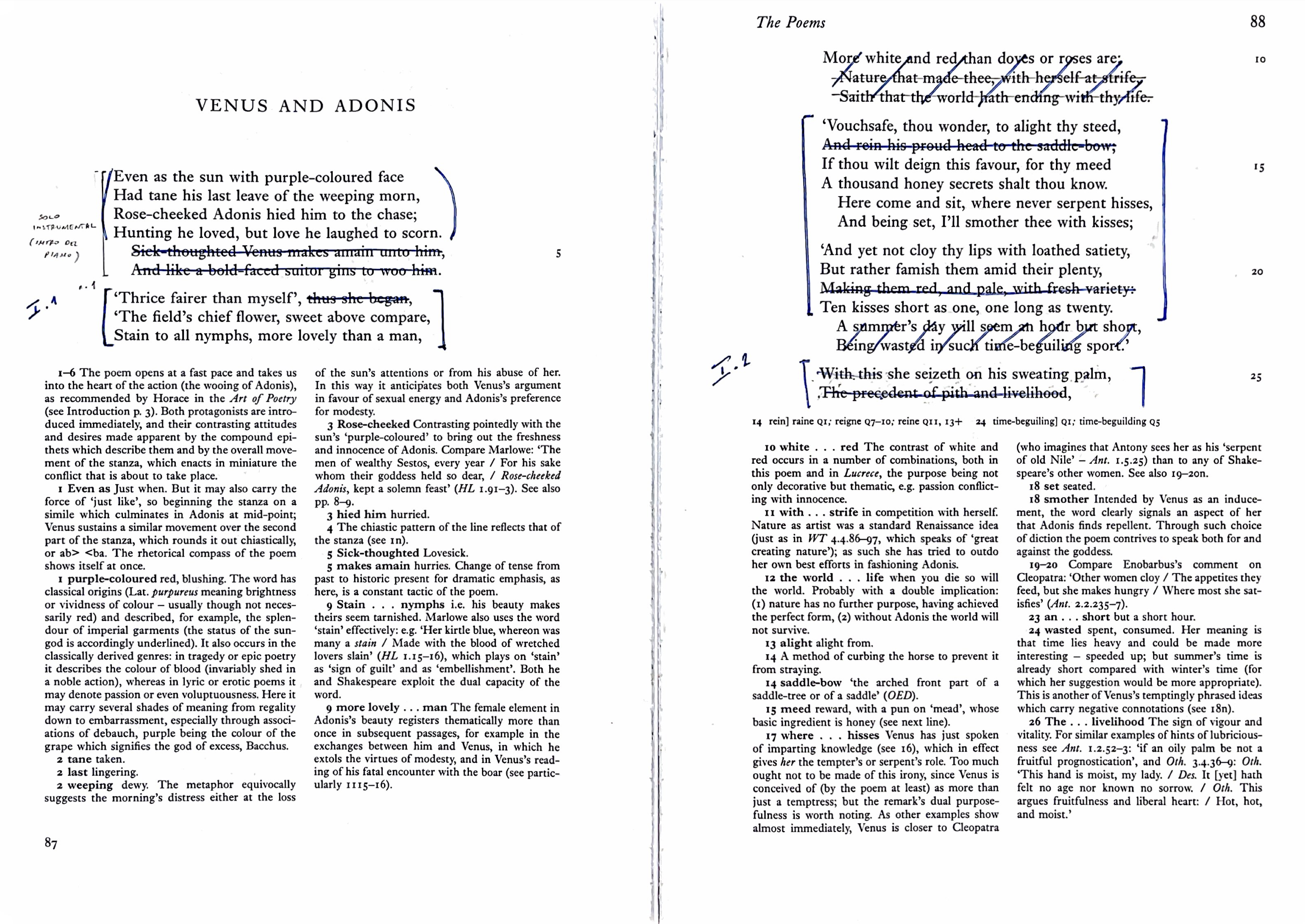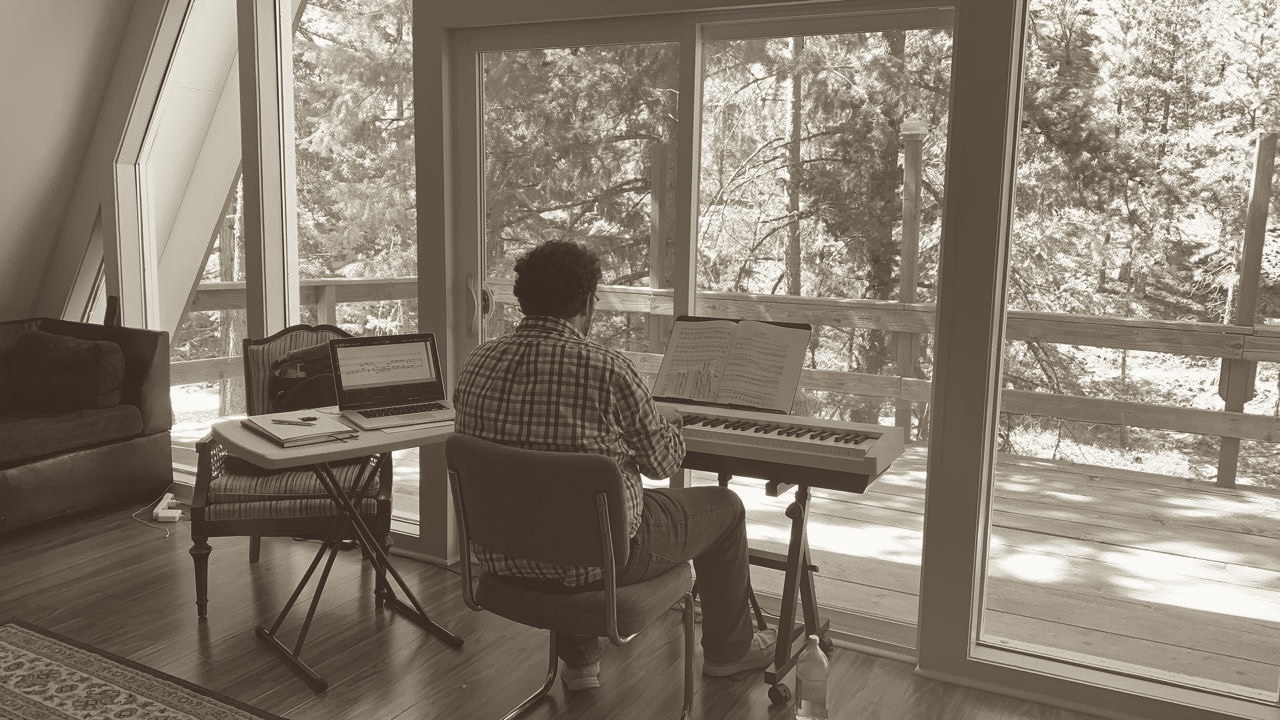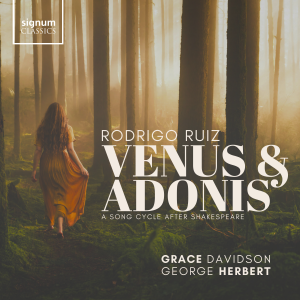Composer, conductor, and mythologist Rodrigo Ruiz has just released his latest project, Venus & Adonis, on Friday September 27, 2024. This innovative album features a song cycle inspired entirely by the eponymous poem by William Shakespeare, marking a distinctive achievement as the first known song cycle based solely on this text. Ruiz, recognized for his sophisticated and expressive compositions, combines Shakespeare’s timeless poetry with contemporary musical elements, creating a unique tribute to Shakespeare in celebration of his 460th anniversary. A dedicated user of Dorico music notation software since its early versions, Rodrigo has utilized Dorico’s advanced features to shape this ambitious project. In this interview, we explore how Ruiz approached the adaptation of Shakespeare’s texts into music, the role of Dorico in his creative process, and the collaborative efforts that brought Venus & Adonis to life. Keep reading to learn more.

Composer, conductor & mythologist Rodrigo Ruiz, photographed by Clément Andriot, © 2024
AN: Hi Rodrigo, could you tell us more about your new album, Venus & Adonis? What inspired you to create a Shakespeare-themed song cycle, and what does this project mean to you personally?
RR: The first spark of inspiration came from the master himself, from Shakespeare and his exquisite verses. I must have read the text a hundred times, stopping on different lines that moved me, discovering new meanings, new joys in each reading. Its beauty is unmatched. The more time I spent with this magnificent narrative poem, the more I liked. Until the idea — actually, it was more a feeling, a hunch, than an idea at first — came to me that perhaps this might be perfect for some sort of musical setting. The only form I could see it take was that of a song cycle. As I imagined it I thought Grace Davidson’s voice would be the perfect vehicle for this. So I spoke to her, and she loved the idea so much she trusted me with its commission. That was the second stage of inspiration. Grace’s voice guided me in my mind as I tried to listen to the ways in which the text wanted to become music. So, this is indeed a very personal and gratifying project, bringing together as it does many things I hold dear — music, literature, mythology, Shakespeare, the piano, and Grace’s voice — in one single album. Its release this year, in 2024, is my way of honouring the master Bard as we celebrate his 460th anniversary.
AN: You’ve been a Dorico user since Dorico 2. How has the software evolved over the years, and what specific features of Dorico were particularly beneficial during the composition of Venus & Adonis?
RR: That was back in 2018! Are you trying to make me feel old? Just kidding! Dorico is always moving forward, so it’s hard to select just one improvement or addition. But one of the most exciting news was certainly the introduction of condensing. It was a game-changer. With a song cycle like Venus & Adonis (V&A) this feature doesn’t really come into play, but condensing made my life much easier and joyful when I worked on my Piano Concerto (2023). For V&A specifically, though, I’d say that Select More was very important, as well as the division of the Setup, Write, Engrave, Play and Print modes as separate entities. But for me sometimes it’s more about what hasn’t changed, rather than what has changed. A feature that’s been there from day one is flows, and they really came in handy for this 17-song project. I was able to change and try out a different order of songs in some cases, and in other cases add or delete songs with incredible speed and ease.
A feature that’s been there from day one is flows, and they really came in handy for this 17-song project. I was able to change and try out a different order of songs in some cases, and in other cases add or delete songs with incredible speed and ease.
AN: This album features a song cycle set entirely to Shakespeare’s poem, which is quite unique. Could you elaborate on the creative process of setting Shakespeare’s words to music? How did Dorico facilitate this process?
RR: Yes. V&A is in fact the only known song cycle to use this poem exclusively — not mixing different works by the Bard. It’s also the first song cycle ever known to be written by a Mexican composer. In order to get to that completed work, though, there was a lot of preparation before the first note could be placed on the staff. The text required careful distillation from its original 1,200-line form to something manageable in the context of a song cycle. This entire process was done in Srivener and with pen and paper, and it eventually was typeset using Apple Pages. Once that was done Dorico comes into play (although I do sketch mostly by hand with or without the piano). Its division of Setup, Write, and Engrave modes is so helpful. I knew from the start I’d be working with just voice and piano, so I turned to Setup mode to get that on the page. Then, I’m only thinking of getting the right notes, rhythms, text, dynamics and articulations in place for each instrument (which is where Write mode comes in). During this time I don’t tweak a single thing as far as typesetting or engraving are concerned. Once I’m done with inputting all that, which is really where the creative process lives, then I worry about engraving. But by the time I turn to the actual engraving process (therefore, Engrave mode) Dorico’s done such a good job behind the scenes that it’s almost done, just like that. It’s minimal things. I usually already know from past experience what the tweaks I have to do to some global settings are (i.e. page margins, note spacing, vertical and horizontal spacing, etc.) to get it closer to where it needs to be, and then I get to some final manual adjustments here and there. It’s a breeze.
- Rodrigo Ruiz composing in Shasta, CA © 2020 Rodrigo Ruiz
- Sketchbook page (RR0_3312) © 2020 Rodrigo Ruiz

Selecting the text © 2019 Rodrigo Ruiz
By the time I turn to Engrave mode Dorico’s done such a good job behind the scenes that it’s almost done, just like that. It’s minimal things. I usually already know from past experience what the tweaks I have to do to some global settings are (i.e. page margins, note spacing, vertical and horizontal spacing, etc.) to get it closer to where it needs to be, and then I get to some final manual adjustments here and there. It’s a breeze.
AN: The song cycle was commissioned by star soprano Grace Davidson and features British artists. How did these collaborations come about, and what role did Dorico play in facilitating the collaboration, especially during the recording process?
RR: Grace and I met back in 2017 when I did my very first album, An Everlasting Dawn. This was before I became a Signum Classics artist. Our mutual friend Kerenza Peacock introduced us because she thought both Grace and I would understand each other musically. Kerenza later commissioned and recorded my Violin Sonata and a couple of other works for Behold the Stars in 2021. When Grace sang for my first recording project I knew I had to write something for her specifically. So when I picked up Shakespeare’s retelling of this touching Greek myth about the goddess of love’s unrequited love to a mortal man I felt there was great potential in there. Grace saw that, too, and the rest is history.
AN: One of the notable stories from the recording is how George Herbert sight-read the entire work due to unforeseen circumstances. How did Dorico’s features help in preparing the music for this kind of situation? Were there specific tools or aspects of Dorico that made last-minute changes or preparations easier?
RR: The way George handled that situation is admirable. It was Sunday night, the night before we started recording V&A for Signum at Snape Maltings, when I received a call from the pianist engaged to record. He had injured himself that afternoon and would not be able to make the sessions. It was mayhem! We were all scrambling, calling everyone we knew in London or thereabouts, to try and find someone last minute to come and save the entire project from complete failure. It was Sunday, though, and late. Some pianists were engaged already, others weren’t in town. Nothing. So we went to sleep and then came at it again early in the morning on Monday. Still nothing. That’s when Grace remembered that the organist at her son’s church was really, really good. She said she thought he would be able to do it. So we called and he was so happy to get that call he immediately hopped on the train. When he came in and we saw what he was doing musically while sight reading our jaws dropped to the floor. And the way George and Grace made music together felt so natural, as if they had played this repertoire for ages together. It was their first time! So, in a stressful situation like this one, with someone having to come in last minute and sight read it’s absolutely crucial to be prepared with some top notch engraving. The page turns need to be just right, the staff size, the note spacing, the layout of the text, all of it contributes to either make the musician’s life so much better — or a real nightmare! Fortunately with Dorico, its general settings, philosophy and care for good engraving practices (as described most clearly in Elaine Gould’s Behind Bars), the final product is always clean and professional, which the musicians and everyone in the studio really appreciated.
AN: As a composer who uses Dorico exclusively, what advice would you give to new users who are just starting with the software? Are there any tips or features that you’ve found particularly useful in your compositions?
RR: I would say to try and come at Dorico with a blank slate. Imagine it really is the first notation software you have ever used. Many newcomers struggle because they’re trying to translate concepts and processes from a previous software into the new one. It’s worth trying to understand Dorico’s philosophy and underlying concepts first, which are very different from the competition.
Also: global settings are your friends. Getting the page templates, Layout Options, Engraving Options, Notation Options, as well as paragraph styles and other global settings right really takes care of about 90–95% of the job. Manual adjustments and local changes tend to be minimal once those larger-scope options are taken care of. I try not to override anything locally until the very end, when and if I absolutely must.
And when nothing else works you know you can always rely on the Dorico Team who handle themselves with such grace, with clear communication, respect and immediate availability and support for all of us users. They have facilitated the creation of this great community on the forums and socials where we all want and like to help each other. I haven’t seen anything like it elsewhere.
AN: What do you hope listeners take away from the album? Are there any particular aspects of the work or its presentation that you are especially excited for them to experience?
RR: The music itself, as an experience, needs to be central. This music should transport us into a sphere of higher emotions. As with any music, I believe the first thing should be to experience the work itself, not any intelectual idea about it, and to let the music play those heart strings. But of course with a song cycle, with words involved (exquisite words!), it’s inevitable there will be several layers of interpretation and experience. That’s where we can let the song cycle transport us even into the world of archetypes. In this case the archetypes are Venus, Adonis, the boar, and all those other important symbols that take shape in Shakespeare’s verse. And to let intuition guide us to see how those archetypes live within us and present themselves, even, in our day to day.
AN: Thanks for your time, Rodrigo!
✩ ♬ ₊˚.🎧⋆☾⋆⁺₊✧ You can stream Rodrigo Ruiz’s Venus & Adonis here, or purchase the album from PrestoMusic, Europadisc Classical, Amazon US or Amazon UK.




